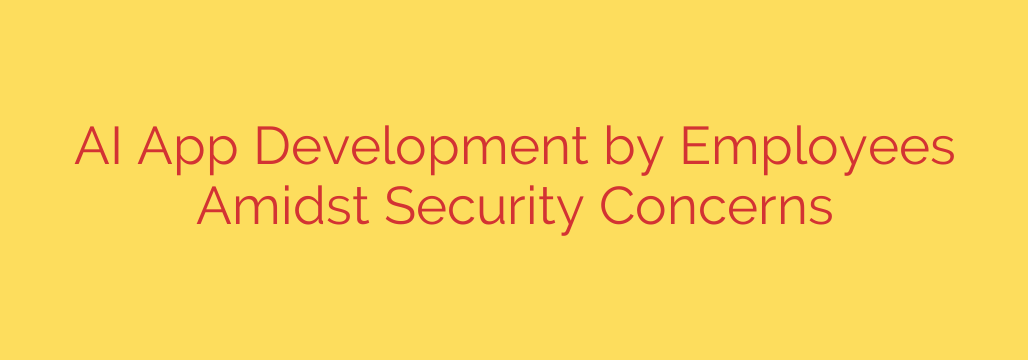
Unlocking Innovation or Opening the Floodgates? The Rise of Employee-Built AI Apps
The age of artificial intelligence is here, and it’s not just being driven by data scientists and IT departments. Motivated employees, eager to boost productivity and solve unique departmental challenges, are increasingly turning to low-code and no-code AI platforms to build their own applications. This wave of “citizen development” promises unprecedented agility and innovation. But beneath the surface of this productivity boom lies a significant and often overlooked security risk.
When employees build AI-powered tools without official oversight, they create a phenomenon known as “Shadow AI.” While their intentions are almost always positive—to automate tedious tasks, analyze data more efficiently, or create custom workflows—the methods can expose a company to severe vulnerabilities. Understanding these risks is the first step toward building a framework that encourages innovation without compromising security.
The Hidden Dangers Lurking in Ungoverned AI
The ease of access to powerful generative AI tools means that an employee can build a functional application in an afternoon. However, without proper security protocols, these well-intentioned projects can quickly become major liabilities.
Here are the primary security concerns that arise from unsanctioned, employee-built AI applications:
Critical Data Exposure: This is perhaps the most immediate and significant threat. To function, AI models need data. Employees may inadvertently upload sensitive information to third-party AI platforms that lack enterprise-grade security. This could include customer personally identifiable information (PII), proprietary intellectual property, financial records, or strategic business plans. Once this data leaves your secure network, you lose control over how it is stored, used, or protected.
Compliance and Regulatory Nightmares: Many industries are governed by strict data privacy regulations like GDPR, CCPA, and HIPAA. An employee-built app that handles customer or patient data without adhering to these regulations can lead to a compliance breach. The resulting penalties can include massive fines, legal action, and irreparable damage to your company’s reputation.
The ‘Black Box’ Problem of No Oversight: When IT and security teams are unaware of these applications, they cannot manage, patch, or monitor them. These apps exist in a “black box,” operating outside of established security frameworks. This lack of visibility means they cannot be vetted for security flaws, integrated properly with other systems, or managed for access control, leaving a wide-open door for potential attackers.
Flawed Logic and Unreliable Outputs: AI models, especially large language models (LLMs), can “hallucinate” or produce inaccurate information. An app built by a non-expert might not have the necessary safeguards to validate its outputs. Making critical business decisions based on flawed or completely fabricated data from an unvetted AI tool can lead to significant operational and financial errors.
Fostering Safe AI Innovation: A Proactive Approach
Banning the use of AI tools is not a viable solution. Doing so would stifle the very innovation and efficiency you want to encourage. The key is not to restrict, but to govern. By implementing a clear and supportive framework, you can empower employees to experiment safely.
Here are actionable steps to harness the power of employee-led AI development while mitigating the risks:
Establish Clear AI Governance Policies: Create and communicate a company-wide Acceptable Use Policy for AI tools. This policy should clearly define what types of data can and cannot be used with external AI platforms. It should also outline the process for getting a new AI-powered application approved and vetted by the IT and security teams.
Provide Vetted and Sanctioned Tools: Don’t leave your employees to search for their own solutions. Proactively research, approve, and provide access to a set of secure, enterprise-ready AI and low-code platforms. By creating a “walled garden” of safe tools, you give employees the creative freedom they desire within a secure environment you control.
Launch Comprehensive Training and Education: Your employees are your first line of defense. Educate them on the risks associated with AI, including data privacy, phishing attempts that leverage AI, and the importance of data classification. A well-informed workforce is better equipped to make smart, secure decisions when building or using new tools.
Promote Collaboration Between Business and IT: Break down silos and foster a culture of partnership. Create a clear channel for employees to bring their ideas for AI applications to the IT department. This allows security and development experts to guide the project, ensuring it is built securely, integrates with existing systems, and delivers reliable results.
Ultimately, the rise of employee-built AI applications is a double-edged sword. It can be a powerful engine for grassroots innovation or a source of critical security vulnerabilities. By taking a proactive, governance-focused approach, organizations can have the best of both worlds—empowering their workforce to build the future while ensuring the company’s digital assets remain protected.
Source: https://www.helpnetsecurity.com/2025/08/15/shadow-ai-genai-apps/








